Many thanks to FanaticbyChoice for sharing the photos** with no text on them** with us!
Additional photos from the photo shoot are featured HERE
Thanks to Ann for helping source this.
Anthony Kiedis: The Pursuit of Happiness
By Chris Norris
How Red Hot Chili Pepper-in-chief
ANTHONY KIEDIS triumphed over a
quarter-century of crippling drug
addiction, band tragedy and
regrettable crotchwear to become
the zen-est dude in rock.
Years ago, Anthony Kiedis and his bandmates were in New York courting an indifferent record industry. They took a time-out to chill in Central Park and were sitting there playing their demo on a boom box when suddenly” -as Kiedis would later rap- “This baby rocked out on the spot/She was a-shakin’ and a-kickin’, that itty bitty tot.” Struck by this toddler’s response, they then observed the same phenomenon in several more wee passersby. At this, the Red Hot Chili Peppers took heart. They may have been broke, their singer may have been a junkie, but their music, as the song title put it, had “baby appeal.” And there is a lesson in patience. Today, those babies are around 25 and the Chili Peppers are the biggest rock band in America.
Not necessarily the top-selling, mind you, but the most iconic, broadest-appealing, most consensus-building. Produced by rock-Midas Rick Rubin, the band’s huge, double-CD Stadium Arcadium has not only gone twice platinum but has also earned the ultimate mainstream accolade of six Grammy nominations, including one for Album of the Year. After a long, insanely turbulent career, singer Kiedis, bassist Michael “Flea” Balzary, guitarist John Frusciante and drummer Chad Smith have found themselves on a new- and, for them, very strange ” plateau. Seven years ago their peers were Limp Bizkit; now they’re U2.
The narrative defies all rock physics. They formed, lost a key member (guitarist Hillel Slovak, to an overdose), survived, kept recording, kept touring and, two decades into their career, hit their creative peak. A bunch of jokers who started out as a punk-rock party gag no one took seriously- themselves included – have become exemplars of the grand rock tradition.
But don’t look to Anthony Kiedis for tears and speeches. It’s a December afternoon, poolside at the Viceroy hotel, and the 44-year-old Kiedis is visibly content to be back in Santa Monica. While our cabana’s little heater is doing its best, this is hardly what you’d summon if you were California dreaming on such a winter’s day: cold, overcast, gloomy – far from tube-sock weather. But Kiedis, just back from the band’s final European tour stop, has seen chillier.
“We flew straight from Stockholm to Inglewood,” he says. “And don’t try to take that flight- it doesn’t exist. We debated whether to arrive home richer or happier and chose happier.” The other three Peppers have scampered to the four corners, leaving Kiedis here alone to bear witness to their glory. As it happens, he’s also the perfect spokesman: the one who’s taken the most lumps, broken the most bones and, arguably, done the most growing.
Right now, he’s sipping a cup of Peet’s coffee (which he forbids himself on tour) and wearing a comfy black V-neck sweater, dark-blue jeans and some gold, well-padded Nikes he acquired after a doctor told him he’d broken bones in both feet by jumping from drum kit to stage. “I played a lot of the tour like that,” he says.
Such is hardly the worst Kiedis has endured fighting the Chili Pepper fight- an epic campaign in which he has suffered everything from shin splints to wrecked vertebrae to egregious comparisons to the Rolling Stones” -British elders in black-music-, substance- and model-appreciation. The analogy’s not totally preposterous: hepcat, roots-plumbing musicians who became rock’s leading brand. This too Kiedis fields manfully.
“They’ve made great music,” he says of the Stones. “But they don’t seem like something I’d like us to be. They don’t seem to have a real band unity. I don’t know that they enjoy the process as much.”
And the process -Kiedis Zen-ishly suggests- is the reward.
“I mean, it’s exciting to get nominations,” he says. “It’s a thrill to hear that the two years we dedicated to making this record mattered. That people got it and felt it. But the ultimate moment of joy and approval happens the minute we write a song. It’s the minute that Chad hears something in John’s playing and I start hearing a melody- and then by the end of the day we’ve got a song.”
That’s the buzz, he says. Not the chicks, the loot, the fame or the awards. It’s the journey. And he actually appears to be sticking to this line of crap.
“In that moment, I feel that the universe says. Good job,” he continues. “You were there to hear the music that the universe had to offer you, and you put it into a song, and now a little girl in New Jersey can go feel that energy in her bedroom.”
Ah. A girl in her bedroom. Now we’re getting somewhere.
Longtime fans of the Chili Peppers know that their vibe has been more than a bit on the randy side – despite the rootsy elegies and soaring psychedelia that characterize their latest work. And, as the band evolved from rubber-faced nudists to battered soul survivors, their singer was always the one walking point, honing their decidedly West Coast blend of carnal, humanist and mystical. So if Kiedis sounds a bit New Age for an American rock star, it’s helpful to remember that he isn’t really American. He’s Los Angelan – alongside Beck, Ice Cube and Vince Neil, one of the most profoundly L.A.-made members of his generation.
Raised mostly in Hollywood by his father, a sometime actor and Sunset Boulevardier, he grew up splitting time between the druggy corners of downtown L.A. and the woodsy arcadias of northern California (also making periodic trips to Michigan to stay with his mom). Ensconced in the late ’70s rock scene and the early ’80s film biz (playing Sylvester Stallone’s son in F.I.S.T.), he wandered an erratic path through Hollywood decadence, punk aggression and Big Sur spirituality. With Fairfax High buddies Flea and Slovak he formed a gag band for a talent show, tapped unexpected rockingness and began a two-decade process that would leave him a strange, highly paid combination of Laguna bohemian, Venice muscle boy, recovering junkie, Tantric-sex god, Gen X mosh star and, most recently, confident rock singer. “We were all trying to have fun and meet girls and take drugs and live the kind of life we’d read about in books,”says Bob Forrest, singer for L.A. band Thelonious Monster, Kiedis’s former roommate and his decades-long friend. “No one ever thought this would happen.”
As he would be the first to admit, Kiedis’s success is the Chili Peppers’ success. Almost no other band shares the kind of brotherhood that he has with childhood pal Flea and the two newer members; the four have been together for well over a decade. Their songs, too, are a group effort, a product of jams and free association. But on Stadium Arcadium and its supporting tours, Kiedis was hands-down Most Improved: supporting the mighty grooves with a sure and full vocal presence and supplying the lyrical ruminations on wayward girls, drowsy civilizations and mass Californiapocalypse. It’s the voice of a banged-up, chastened and compassionate low-life veteran.
No one would have bet on this. On just the second page of Kiedis’s best-selling 2004 memoir, Scar Tissue, the list of stuff that’s gone into his veins includes cocaine, speed, Black Tar heroin, Persian heroin and, once, even LSD. (What, no Drano?) And the tabloid accounts of his former paramours read so much like a who’s-who of the beautiful and famous as to suggest a postpunk Frank Sinatra. Instead of Ava Gardner, Marilyn Monroe and Mia Farrow, we’ve got Ione Skye, Sofia Coppola, Sinead O’Connor, Heidi Klum plus wild cards like German punk-cabaret singer Nina Hagen thrown in for good measure. When you’ve loved and lost like Kiedis has, then you know what life’s about. Or at least you look like you do.
And indeed the man who sits coffee-sipping before Blender is no fresh-faced kid. His straight chestnut hair is shoulder-length and center-parted, giving his narrow face a carved American Indian look that may show early signs of Iggy Pop syndrome. His dark eyes seem warm if slightly guarded, his demeanor easygoing, his speech thoughtful. He obligingly reveals the latest tattoo on his famously inked-up body: a beautifully rendered koi fish on his forearm. It’s a symbol of overcoming adversity,” he says. “Of swimming up current, so to speak.” Around his left wrist he wears a diver’s watch and a red string. The latter, he says, “reminds me not to fuck with people. It’s supposed to prevent you from receiving the negative intentions of other people, which I’m not terribly worried about. But I do need a reminder not to throw negative fireballs at others.”
It’s a thoughtful gesture. Because, simply by surviving and thriving, Kiedis has become one of the foremost potential bad influences for a new generation. For decades, whenever youngsters were inclined to experiment with their lifestyle, certain public figures were there to make the choice seem viable. There was Beat writer William S. Burroughs: unrepentant heroin, pill and Moroccan-boy aficionado – lived to be 180. Keith Richards: incorrigible partier and millionaire -once quipped, “I’ve never had a problem with drugs, I’ve had problems with police.”And now Kiedis – who has survived the drug-related deaths of bandmate Slovak and friends River Phoenix, Kurt Cobain and many others, stayed a junkie for years after and finally made it to health, wealth and sobriety unscathed. Does he feel responsibility to counsel others against bad choices?
“I don’t,” he says. “I’ve lost the need to push my ideas or experiences on other people.” He does, however, make a savvy point. “It’s easy to be a junkie. It’s not easy to be one of the greatest guitar players of all time, or one of the greatest writers.” As an alt-rock-credentialed artist with incongruously great abs, Kiedis acknowledges he’s walking a different path from most of his cultural heroes. “The majority of the music that I love comes from people who are in rebellion against the physical part of their lives,”he says. “Joey Ramone, for instance. But I think the two go together great. There’s something absolutely freeing about being able to turn your body into a whirling dervish. There’s a reason why people have danced for 20,000 years. Dancing gets the attention of the spirits.”
If not the spirits, something’s clearly working in Kiedis’s favor. At 44, he has the body of a surf stud. While in his book he has copped to shooting ozone -as treatment for hepatitis C – there’s got to be some other health secret. Ashtanga yoga? Tai chi? Strippercise?
Nope. He doesn’t even work out. “The last time I worked out was probably in 1990,” he says. “Somewhere along the way I realized that I could get my body to be the way I wanted without working out.”
His only secret, he says, is Pepperdom. “Performing, dancing and singing simultaneously – if you can do all that and hit the notes, you’re in there. My nurse recently went to karaoke and tried to do ‘Can’t Stop’ and said that halfway through she was out of breath. And she’s an athlete.”
Indeed, the life of a funk-rock shaman is no day at the gym. One might assume that even sans drugs, this arm-candied bachelor still pursues various libidinal excesses. Few public figures have made sex such a central part of their message as did the frontman who blazed through rock’s flannel-clad, bummer-nursing ’90s as an odd-stud out – only seeming part of rock’s sexual mainstream during our regretful ho-macking Limp Bizkit era. But this is not an association he cherishes.
“Yeah,” he says, after a lengthy exhale. “Energetically, I’ve certainly been guilty of that which I don’t support. Obviously, sex can have a dark side. And it’s one the modern world can make darker. “When I finally got a computer, I discovered this limitless world of pornography. And I recognized the feeling that I was having was like the feeling that I used to get when I’d go score drugs. I actually had to make a commitment to myself to stop.”
“I don’t really attract that kind of energy now, anyway,” he says of casual hookups. “You really get what you put out there.” A serial monogamist -albeit a monogamist whose recently reported squeezes were models Jaime Rishar and Jessica Stam – Kiedis is now more interested in permanence. “And you don’t want to date a fan. I don’t think I would be attracted to someone who’s too attracted to me. My Spidey sense doesn’t allow that.”
Instead, his Spidey sense most recently drew him to a young woman he first espied at a rooftop party in Hollywood. “I saw this beautiful face smiling throughout the night,” he recalls. He said hello, found out she had a boyfriend, but cadged a commitment to have coffee. After some time apart, he and 20-year-old Heather Christie reconnected and began dating, and they are now cohabitating. “On paper there was no reason whatsoever we should have gotten along,”he says of Christie, who on their first date took him on a tour of her hometown of Simi Valley. “But when I hung out with her, I didn’t want to hang out with anybody else.”
Image
They’re even considering a little Kiedis. “Yes, I wanna have kids,” he confirms.
Thus, the new Kiedis. He lives in L.A. but not Hollywood. He prefers his Vespa to his Harley. (“Not as fast, but quieter and I can write songs while I ride.”) And as far as music goes, Kiedis’s tastes have broadened if not mellowed. “I’ll listen to anything now,” he says. “I even try to keep an open mind for simple pop music, which I used to make a living detesting.”
Shortly after we wrap at the hotel, Blender meets a source of this broadmindedness. After he begged off to go check on his slightly under-the-weather girlfriend, Kiedis cell-phoned to say she’d invited Blender for lunch.
Slim and angel-faced, with auburn hair and a flannel shirt, Christie sits at the bar of a gourmet diner across the street from the hotel, wearing a butterfly pendant from celebrity designer Tarina Tarantino around her neck- a recent gift from Kiedis. While the two chat over tuna salad with truffle oil, Kiedis obliges Blender by following up an earlier line of questioning: “Maybe you can clarify something,” he says to Heather. “He asked if we had musical arguments. I told him that you were a big Nick Lachey lover.”
“What!?” Heather says. “Not really.” Then she adds, “Oh, and by the way, John Frusciante also likes Nick Lachey.”
“No!”
“I’m serious.”
Heather explains that the former Mr. Jessica Simpson shared an afternoon with the Red Hot Chili Peppers on TRL and took three takes performing his hit. By the third time he sang it, John was like, “I really like this song,” she reports. “And he learned it on his guitar.”
Kiedis resumes the questioning: “So what do I play that you’re just like, ‘No. Turn it off?”
“You mean, besides the Rolling Stones?!” she exclaims.
Later, Kiedis reveals that Heather was one of the inspirations for the new song ‘She’s Only 18.’It begins ‘She’s only 18/Don’t like the Rolling Stones.’ It’s an immutable law of love that you can’t enjoy or detest a song with the same passion once someone you love feels otherwise.
“Hey,” Kiedis says, gently nudging Heather. “Did I ruin Nick Lachey for you?”
Luckily, there are other artists, other bands. And in fact, one of Kiedis’s new faves happens to have a gig the very next day. It’s an up-and-coming local act called the Jack Bambis. At Kiedis’s urging, Blender agrees to catch their show.
The gig is on a beautiful, clear-skied Sunday at a farmer’s market, held in a Los Feliz parking lot. Food stands sell gourmet tamales. Near the entrance, amps, monitors and a carpet-bound drum set have been hastily arranged. And as two pint-size, shaggy-haired, Kurt Cobain looking kids pick up guitar and bass, it’s clear the Jack Bambis have a good four decades before they’re eligible for the Rock and Roll Hall of Fame.
Guitarist Indio (son of Robert Downey Jr.), bassist Jasper and lead singer Lia are all 13. Drummer Cash, a sprout in a backward navy baseball hat, is 9, son of a longtime Kiedis friend. As the quartet bashes out a raw but intimidatingly accomplished swamp-metal boogie, the ambience is something between a Minutemen show and a PTA meeting, with grizzled rock vets and Beverly Hills soccer moms cheering on the kids.
Standing to the side, arm in arm with Heather, Kiedis looks down next to him to see a tyke of 3 in a tiny hoodie that says NORTH SHORE SURF. Exposed to the raucous bashing, the kid is simply losing it: bouncing uncontrollably, stomping either foot, flailing his stubby arms, banging his downy head. He looks happily possessed.
Kiedis leans over and starts an impromptu pas de deux: squaring off with the tot, throwing his arms out like a boxer, aiding and abetting the wee toddler rock.
“This little guy here is their biggest fan,” the boy’s mom yells over the din. The little guy looks up at Kiedis and beams. Kiedis, deadpan behind his shades, continues his loose-limbed boogie – then rises to get back to his girl.








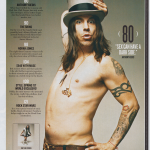

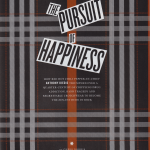
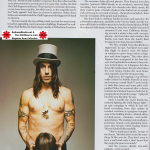
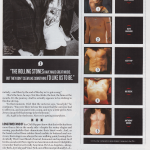
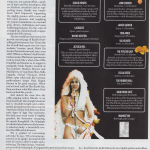
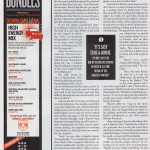
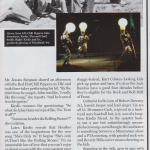


eighth photo – I’am this girl: P 😀
Around his left wrist he wears a red string. “It reminds me not to fuck with people. It’s supposed to prevent you from receiving the negative intentions of other people, which I’m not terribly worried about. But I do need a reminder not to throw negative fireballs at others.”
This is honestly so meaningful and telling!